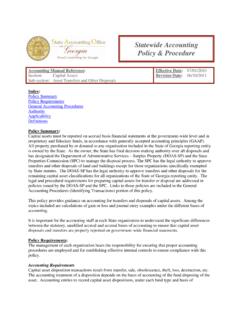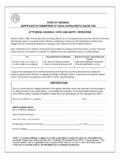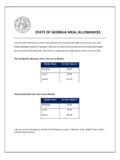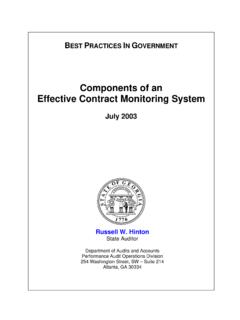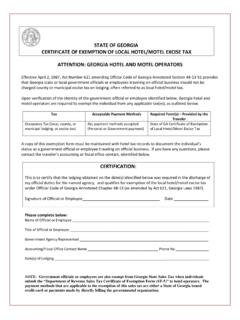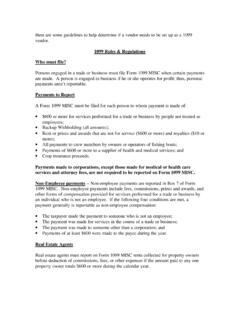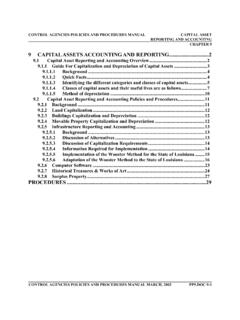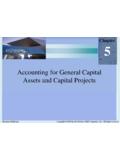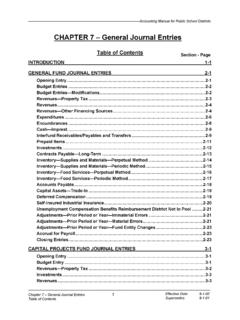Transcription of Statewide Accounting Policy & Procedure - Georgia
1 Accounting Manual Reference: Section: capital Assets Sub-section: capital Assets General Effective Date: 07/01/2010 Revision Date: 06/30/2011 Index: Policy Summary Policy Requirements General Accounting procedures Authority Applicability Definitions Policy Summary: capital assets, in general, should be accounted for in accordance with generally accepted Accounting principles (GAAP). The capital Assets section of the Accounting Policy Manual provides comprehensive guidance on Accounting for capital assets and reporting the activity in the Comprehensive Annual Financial Report (CAFR). Although this section also requires a complete physical inventory of capital assets at least every two years to confirm existence, it does not specify the operational process to be used to conduct the physical inventories which are critical to safeguarding the State s assets. This section also does not address physical inventory requirements for non- capital assets ( , assets held in trust, controlled assets such as weapons, and other assets that cost less than $5,000, etc.)
2 Among the topics included in this General sub-section of the capital Assets policies are: asset class descriptions, capitalization thresholds, depreciation methodologies, examples of the types of expenditures that qualify for capitalization in each asset class, journal entry examples for acquisitions and depreciation, and disclosure requirements. Other sub-sections of the capital Assets section address topics such as construction in progress, asset transfers, dispositions, intangibles, internally generated computer software and impairments. It is important for the Accounting staff at each State organization to understand the significant differences between the statutory, modified accrual and full accrual bases of Accounting to properly account for capital assets. State organizations should refer to the Overview sub-section of the Basis of Accounting and Reporting section of the Accounting Policy Manual for guidance on the different bases of Accounting .
3 The primary differences, as they relate to capital assets, are summarized below. Governmental Funds capital assets acquired by governmental funds are recorded as expenditures in the individual funds making the acquisitions. The focus of governmental funds is the flow of current financial resources. Accordingly, only financial assets are reported on the balance sheet of governmental funds. Financial assets are assets which can be spent now or which can be expected to become available for spending in the future. General capital assets are not included in that definition. General capital assets are capital assets of the government that are not specifically related to activities reported in proprietary or fiduciary funds. Although GAAP does not require capital assets to be reported in the governmental fund financial statements, GAAP does require that capital assets, net of accumulated depreciation/ Statewide Accounting Policy & Procedure State of Georgia SAO Statewide Accounting Policy & Procedure capital Assets General Page 2 of 21 amortization, be reported in the governmental activities column of the government-wide financial statements.
4 In the government-wide financial statements, assets are capitalized only when the cost of the asset meets the capitalization threshold for the asset class as established below and when the asset has a useful life greater than one year. Depreciation or amortization of governmental capital assets applies only to assets that have been capitalized. Proprietary Funds and Fiduciary Funds capital assets acquired by proprietary funds and fiduciary funds should be recorded as assets in the individual funds making the acquisitions. Within these funds the purchase of a capital asset affects only the statement of net assets. The purchase of a capital asset is not recorded as an expense because, under the flow of economic resources measurement focus and the accrual basis of Accounting , the funds are not economically affected when liquid assets ( , cash) are exchanged for capital assets. Component Units Component units of the State should refer to the information on governmental, proprietary, and fiduciary funds above.
5 For CAFR reporting purposes, blended component units are reported in the appropriate fund type. Discretely presented component units are reported in the CAFR at the government-wide level only; as such, information on these component units is reported on the accrual basis of Accounting . State organizations included in the State of Georgia Appropriations Act must maintain Accounting records which provide sufficient information to report on the full accrual, modified accrual (where appropriate) and budgetary bases. capital assets must be capitalized under the accrual basis but recorded as expenditures under the modified accrual basis. This objective can be accomplished either by maintaining subsidiary Accounting records or by preparing conversion entries to modified accrual and full accrual basis for reporting at fiscal year-end. Policy Requirements: Management within each reporting organization is responsible for the implementation of this Policy and must ensure that proper Accounting procedures and internal controls are in place.
6 Accounting Requirements Overview capital assets of governmental funds are recorded as expenditures at the time of purchase and capitalized in the governmental activities column of the government-wide statement of net assets. capital assets of the State s proprietary funds are capitalized in the fund in which they are used and are also reported in the government-wide statement of net assets. Because discretely presented component units are reported only in the government-wide statements, capital assets of these component units are also capitalized and reported in the government-wide statement of net assets. capital assets of fiduciary funds are capitalized and reported only in the fiduciary fund statement of fiduciary net assets. capital assets are stated at historical cost or, in some instances, estimated historical cost. Donated capital assets are stated at fair value (FV) at the time of donation. An asset purchased for $1 (or a similar nominal cost well below FV) is treated as a donated asset and capitalized based on its FV at the time of donation.
7 All land and non-depreciable land improvements are capitalized regardless of cost, except for land and other real estate held as investments by endowments. Endowments are required to report these land and other real estate investments at FV and to report the changes in FV as investment income. The cost of normal maintenance and repairs that do not add to the value of an asset or materially extend the asset s life is not capitalized. The State holds certain assets such as works of art, historical documents, State of Georgia SAO Statewide Accounting Policy & Procedure capital Assets General Page 3 of 21 and artifacts that have not been capitalized or depreciated because the collections are protected and preserved for exhibition, education, or research and are considered to have inexhaustible useful lives. Major outlays for construction of bridges and roadways in the state highway system are capitalized as projects are constructed.
8 For internally generated computer software, only costs incurred during the application development stage are capitalized. All other major construction projects are capitalized when projects are completed. Interest incurred during construction is not capitalized for governmental activities, but it is included in the capitalized value of assets constructed for use in proprietary enterprise funds. Capitalization Thresholds Assets purchased, constructed, or received through capital lease or donation must be uniformly grouped into major classes in accordance with Statement No. 34, paragraphs 116 117. The following table summarizes the non-federal fund source capitalization thresholds for the State s primary classifications of capital assets. Amounts are capitalized, under the full accrual basis of Accounting , when the cost or value equals or exceeds these thresholds. Items acquired through capital leases or donations are subject to these capitalization thresholds, using the classifications most closely related to the leased or donated assets.
9 Non-Federal Fund Source Capitalization Threshold Schedule Class of asset Threshold* Land/land improvements (other than that held as investments by endowments) Capitalize All Land/land improvements held as investments by endowments (not treated as capital assets) Record as an Investment at FV Buildings/building improvements $100,000 Improvements other than buildings $100,000 Infrastructure, bridges and roadways included in the state highway system Capitalize All Infrastructure, other $1,000,000 Intangible assets, other than software $100,000 Personal property (machinery/equipment/furniture/vehicles) $5,000 Library books/materials (collections): Initial threshold for aggregate collection Additions if aggregate collection equals or exceeds initial threshold $100,000 Capitalize All Works of art/historical treasures Capitalize All Software $1,000,000 * See OMB Circulars A-21 (educational institutions), A-87 (state and local governments), or A-122 (non-profit organizations) for federal funds thresholds.
10 Recognition and Measurement capital asset Acquisition Cost capital assets must be recorded and reported at their historical costs, which include the vendor s invoice (plus the value of any trade-in), sales tax, initial installation cost (including in-house labor), modifications, attachments, accessories or apparatus necessary to make the asset usable and render it into service. Historical costs also include ancillary charges such as freight and transportation charges, site preparation costs and professional fees. Note: Not all costs that are included in capitalized acquisition cost are eligible for reimbursement from general obligation (GO) bonds ( in-house payroll and payroll-related costs). Refer to the GSFIC Reimbursements for Bond Funded Construction Projects section of the Accounting Policy Manual for guidance on expenditures that are eligible to be reimbursed State of Georgia SAO Statewide Accounting Policy & Procedure capital Assets General Page 4 of 21 with the proceeds from the sale of general obligation bonds issued by the Georgia State Financing and Investment Commission (GSFIC).
